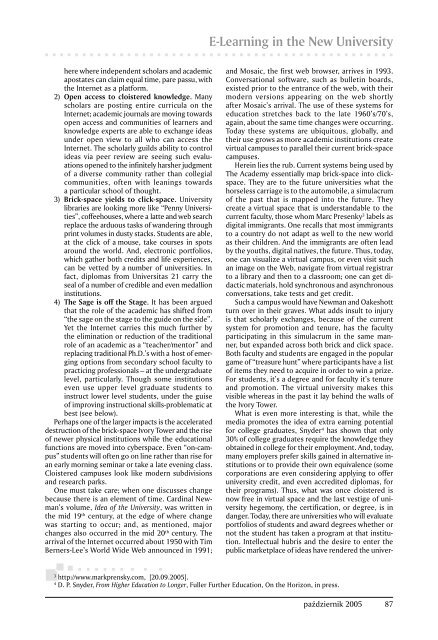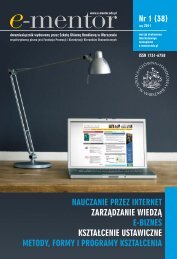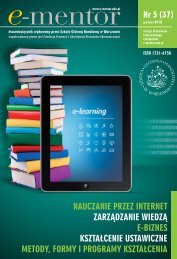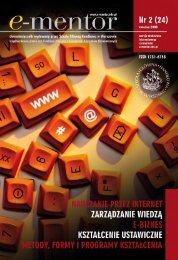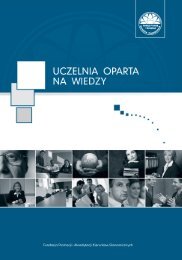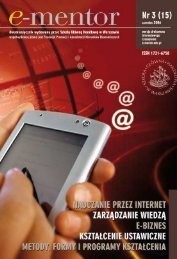metody, formy i programy ksztaÅcenia - E-mentor
metody, formy i programy ksztaÅcenia - E-mentor
metody, formy i programy ksztaÅcenia - E-mentor
Create successful ePaper yourself
Turn your PDF publications into a flip-book with our unique Google optimized e-Paper software.
E-Learning in the New Universityhere where independent scholars and academicapostates can claim equal time, pare passu, withthe Internet as a platform.2) Open access to cloistered knowledge. Manyscholars are posting entire curricula on theInternet; academic journals are moving towardsopen access and communities of learners andknowledge experts are able to exchange ideasunder open view to all who can access theInternet. The scholarly guilds ability to controlideas via peer review are seeing such evaluationsopened to the infinitely harsher judgmentof a diverse community rather than collegialcommunities, often with leanings towardsa particular school of thought.3) Brick-space yields to click-space. Universitylibraries are looking more like “Penny Universities”,coffeehouses, where a latte and web searchreplace the arduous tasks of wandering throughprint volumes in dusty stacks. Students are able,at the click of a mouse, take courses in spotsaround the world. And, electronic portfolios,which gather both credits and life experiences,can be vetted by a number of universities. Infact, diplomas from Universitas 21 carry theseal of a number of credible and even medallioninstitutions.4) The Sage is off the Stage. It has been arguedthat the role of the academic has shifted from“the sage on the stage to the guide on the side”.Yet the Internet carries this much further bythe elimination or reduction of the traditionalrole of an academic as a “teacher/<strong>mentor</strong>” andreplacing traditional Ph.D.’s with a host of emergingoptions from secondary school faculty topracticing professionals – at the undergraduatelevel, particularly. Though some institutionseven use upper level graduate students toinstruct lower level students, under the guiseof improving instructional skills-problematic atbest (see below).Perhaps one of the larger impacts is the accelerateddestruction of the brick-space Ivory Tower and the riseof newer physical institutions while the educationalfunctions are moved into cyberspace. Even “on-campus”students will often go on line rather than rise foran early morning seminar or take a late evening class.Cloistered campuses look like modern subdivisionsand research parks.One must take care; when one discusses changebecause there is an element of time. Cardinal Newman’svolume, Idea of the University, was written inthe mid 19 th century, at the edge of where changewas starting to occur; and, as mentioned, majorchanges also occurred in the mid 20 th century. Thearrival of the Internet occurred about 1950 with TimBerners-Lee’s World Wide Web announced in 1991;and Mosaic, the first web browser, arrives in 1993.Conversational software, such as bulletin boards,existed prior to the entrance of the web, with theirmodern versions appearing on the web shortlyafter Mosaic’s arrival. The use of these systems foreducation stretches back to the late 1960’s/70’s,again, about the same time changes were occurring.Today these systems are ubiquitous, globally, andtheir use grows as more academic institutions createvirtual campuses to parallel their current brick-spacecampuses.Herein lies the rub. Current systems being used byThe Academy essentially map brick-space into clickspace.They are to the future universities what thehorseless carriage is to the automobile, a simulacrumof the past that is mapped into the future. Theycreate a virtual space that is understandable to thecurrent faculty, those whom Marc Presenky 3 labels asdigital immigrants. One recalls that most immigrantsto a country do not adapt as well to the new worldas their children. And the immigrants are often leadby the youths, digital natives, the future. Thus, today,one can visualize a virtual campus, or even visit suchan image on the Web, navigate from virtual registrarto a library and then to a classroom; one can get didacticmaterials, hold synchronous and asynchronousconversations, take tests and get credit.Such a campus would have Newman and Oakeshottturn over in their graves. What adds insult to injuryis that scholarly exchanges, because of the currentsystem for promotion and tenure, has the facultyparticipating in this simulacrum in the same manner,but expanded across both brick and click space.Both faculty and students are engaged in the populargame of “treasure hunt” where participants have a listof items they need to acquire in order to win a prize.For students, it’s a degree and for faculty it’s tenureand promotion. The virtual university makes thisvisible whereas in the past it lay behind the walls ofthe Ivory Tower.What is even more interesting is that, while themedia promotes the idea of extra earning potentialfor college graduates, Snyder 4 has shown that only30% of college graduates require the knowledge theyobtained in college for their employment. And, today,many employers prefer skills gained in alternative institutionsor to provide their own equivalence (somecorporations are even considering applying to offeruniversity credit, and even accredited diplomas, fortheir programs). Thus, what was once cloistered isnow free in virtual space and the last vestige of universityhegemony, the certification, or degree, is indanger. Today, there are universities who will evaluateportfolios of students and award degrees whether ornot the student has taken a program at that institution.Intellectual hubris and the desire to enter thepublic marketplace of ideas have rendered the univer-3http://www.markprensky.com, [20.09.2005].4D. P. Snyder, From Higher Education to Longer, Fuller Further Education, On the Horizon, in press.październik 2005 87


